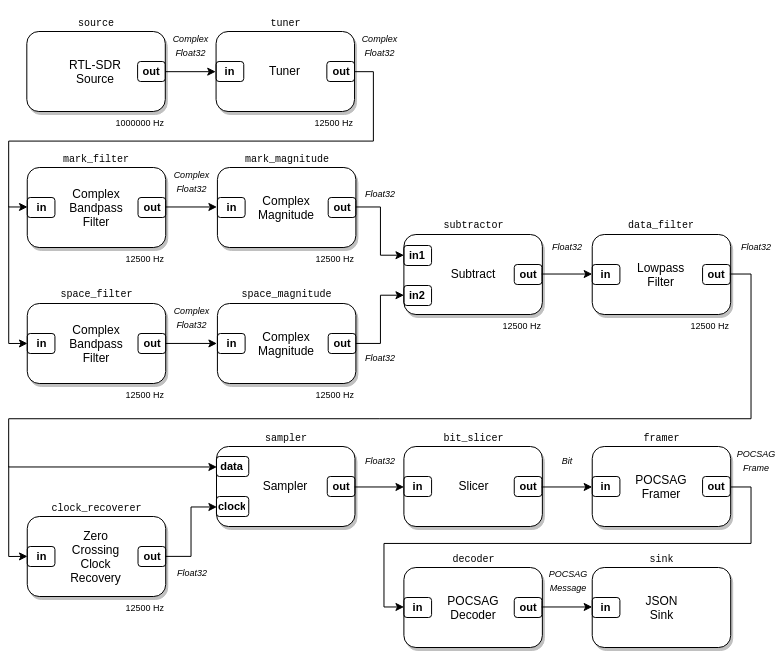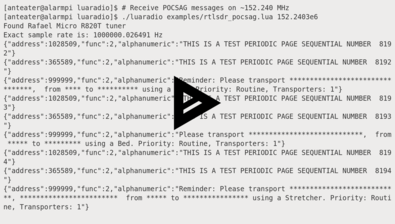rtlsdr_pocsag.lua
This example is a POCSAG receiver. It can be used to receive pager messages dispatched by hospital, fire, emergency, and police services, as well as some businesses. POCSAG messages are transmitted in plaintext. It uses the RTL-SDR as an SDR source, writes decoded POCSAG messages in JSON to standard out, and shows two real-time plots: the RF spectrum and the demodulated bitstream.
This POCSAG receiver composition is available in LuaRadio as the
POCSAGReceiver block.
Flow Graph

Source
local radio = require('radio')
if #arg < 1 then
io.stderr:write("Usage: " .. arg[0] .. " <frequency>\n")
os.exit(1)
end
local frequency = tonumber(arg[1])
local tune_offset = -100e3
local baudrate = 1200
-- Blocks
local source = radio.RtlSdrSource(frequency + tune_offset, 1000000)
local tuner = radio.TunerBlock(tune_offset, 12e3, 80)
local space_filter = radio.ComplexBandpassFilterBlock(129, {3500, 5500})
local space_magnitude = radio.ComplexMagnitudeBlock()
local mark_filter = radio.ComplexBandpassFilterBlock(129, {-5500, -3500})
local mark_magnitude = radio.ComplexMagnitudeBlock()
local subtractor = radio.SubtractBlock()
local data_filter = radio.LowpassFilterBlock(128, baudrate)
local clock_recoverer = radio.ZeroCrossingClockRecoveryBlock(baudrate)
local sampler = radio.SamplerBlock()
local bit_slicer = radio.SlicerBlock()
local framer = radio.POCSAGFramerBlock()
local decoder = radio.POCSAGDecoderBlock()
local sink = radio.JSONSink()
-- Plotting sinks
local plot1 = radio.GnuplotSpectrumSink(2048, 'RF Spectrum', {yrange = {-120, -40}})
local plot2 = radio.GnuplotPlotSink(2048, 'Demodulated Bitstream')
-- Connections
local top = radio.CompositeBlock()
top:connect(source, tuner)
top:connect(tuner, space_filter, space_magnitude)
top:connect(tuner, mark_filter, mark_magnitude)
top:connect(mark_magnitude, 'out', subtractor, 'in1')
top:connect(space_magnitude, 'out', subtractor, 'in2')
top:connect(subtractor, data_filter, clock_recoverer)
top:connect(data_filter, 'out', sampler, 'data')
top:connect(clock_recoverer, 'out', sampler, 'clock')
top:connect(sampler, bit_slicer, framer, decoder, sink)
if os.getenv('DISPLAY') then
top:connect(tuner, plot1)
top:connect(data_filter, plot2)
end
top:run()
Usage
Usage: examples/rtlsdr_pocsag.lua <frequency>
Running this example in a headless environment will inhibit plotting.
You may need to explore your local spectrum with a waterfall receiver to find a POCSAG transmitter.
Usage Example
Receive POCSAG on 152.240 MHz:
$ ./luaradio examples/rtlsdr_pocsag.lua 152.240e6
{"address":1234567,"func":2,"alphanumeric":"THIS IS A TEST PERIODIC PAGE SEQUENTIAL NUMBER 1973"}
{"address":234567,"func":2,"alphanumeric":"THIS IS A TEST PERIODIC PAGE SEQUENTIAL NUMBER 1973"}
{"address":1234567,"func":2,"alphanumeric":"THIS IS A TEST PERIODIC PAGE SEQUENTIAL NUMBER 1974"}
{"address":234567,"func":2,"alphanumeric":"THIS IS A TEST PERIODIC PAGE SEQUENTIAL NUMBER 1974"}
{"address":1234567,"func":2,"alphanumeric":"THIS IS A TEST PERIODIC PAGE SEQUENTIAL NUMBER 1975"}
{"address":234567,"func":2,"alphanumeric":"THIS IS A TEST PERIODIC PAGE SEQUENTIAL NUMBER 1975"}
...

